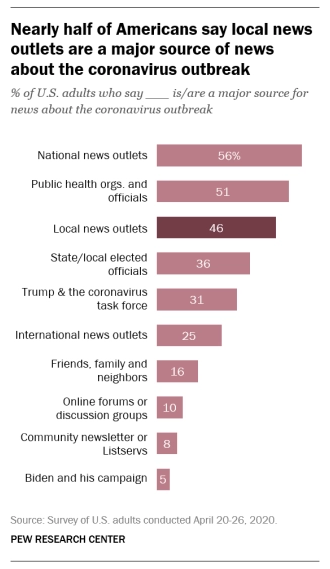ATLANTA – Local news outlets this year have shown their power to reach viewers during times of crisis, as people seek information about that has the biggest effect on their regions. That’s especially true during the pandemic, as various cities and states implement differing policies to halt the spread of COVID-19 based on the most immediate circumstances.
“Throughout COVID, we’ve seen huge increases in local news viewing. That just demonstrates it’s a really trusted source of information, specifically about the pandemic,” Martha Matthews, senior vice president and group director of local media activation at agency Carat, said in this interview with Beet.TV. “Younger viewers are driving that growth of news consumption.”
About half (46%) of Americans said local news outlets are a major source of news about the coronavirus, Pew Research Center found in a survey. In addition, 61% of U.S. adults said they were following news about the coronavirus outbreak at both the national and local level equally.
That engagement is a key reason why advertisers embrace news programming when they’re running local campaigns.
“Local news is actually a huge selling point for our clients because it really allows brands to connect at the local level, to integrate with communities and align with that local news content,” Mathews said. “If news is a vital mix to a client’s daypart, we typically advise that they look for news sponsorships because that’s going to really allow them to have a non-pre-emptible presence in that daypart.”
Audience-Based Buying
Carat has an audience-based approach to media buying, harnessing the insights from Dentsu Aegis Network’s M1 platform, which is mapped to 242 million U.S. adult consumers. The people-based data allow for cross-platform targeting.
“We try not to silo the channels, and we see audiences in a fluid fashion,” Matthews said. “We like to say, ‘we’re buying audiences and not channels.’ We’ve seen a shift from linear to more audience-based, data-driven buying like addressable and OTT, but even our linear buys are using data directionally for more precise channel and programming-level selections at the individual market level.”
Carat relies on local Comscore audience data, which can be integrated with information from Simmons Market Research Bureau or Experian.
“That allows us to look beyond age and gender … and incorporate those behavioral and qualitative factors into our programming decisions,” Matthews said. “Scale is a challenge in local, but I’m confident the landscape will continue to evolve when it comes to data and audiences.”
As buyers and sellers of media increasingly talk about a “common currency” that unifies audience metrics for traditional channels like linear television with newer digital platforms, Carat is seeking insights into viewing behavior as it happens.
“In looking at cross-platform measurement, not all impressions are created equal. The measurement standards between linear and digital are vastly different,” Matthews said. “We need to determine what constitutes a platform-agnostic impression when it comes to content viewership across all platforms.”
This video is part of Advancing Toward a Common TV Measurement Currency, a Beet.TV leadership series presented by Comscore. For more videos from the series, please visit this page.




































